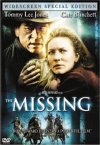BUY THE DVD:
|


|
|
|
SYNOPSIS:
| |
in 19th century new mexico, a woman's daughter is kidnapped and the woman and her estranged father try to find her.
|
|
|
MOVIE FACT:
| |
the working title for this film was, "the last ride."
|
|
|
RATING:
|



three out of four possible stars
|
|
|
|
Director Ron Howard has tackled several different genres of film during his outings behind the camera and The Missing represents the second time he has ventured into the world of the nineteenth century American West. In his 1992 effort, the mildly entertaining cinematic misfire, Far And Away, Howard and his editor made the rather egregious mistake of taking a few minutes too long to bring their film to a conclusion. And in revisiting that almost mythical world, Howard again seems to have let his favor for certain scenes and pieces of dialogue overcome his sense of concise filmmaking.
The Missing is about a half an hour too long and just when the second act is wrapping up, it seems the picture itself should be much closer to its conclusion. But after several false endings, the film concludes at a point when the audience's emotional participation in the feature might be less intense than it should have been, given the intense performances by the stellar cast. In point of fact, if not for the talent of lead performers Tommy Lee Jones and Cate Blanchett, who play an estranged father and daughter, the film might have resembled more the far too leisurely Far And Away.
But Jones shows his ability to include the entire spectrum of human emotion into his character, from laughter to anger to tears. When the film begins, his character, "Samuel Jones," has abandoned his family decades in the past and Blanchett, whose character, "Maggie Gilkeson," grew up under the harshest of circumstances, wants nothing to do with him when he comes to her farm to attempt reconciliation. The relationship between these two characters is the frosting on the somewhat tepid cake of a plot of this film and with the help of an intense supporting cast, the predictability of the film is lessened significantly.
In particular, young actress Jenna Boyd plays her role as "Dot," Blanchett's daughter, with a vitality and intelligence that prevents her character from resembling the sort of emotional child characters that can easily grate on one's nerves. It isn't exactly Boyd's dialogue that is impressive (the script is more standard than notable), but instead the emotions that exist behind those words that will make viewers take notice. As with many of his films, Howard also allows his actors to use the silence between their lines, and Boyd seems a master of this technique even through her young years.
And when Howard's directorial technique doesn't backfire by extending the film's running time, all of his actors make it easy to forget you know exactly what's coming next. Playing a role that represents one of the most wicked characters to appear on screen in quite a while, Eric Schweig, most notable for his appearance in the 1992 film, The Last of the Mohicans, performs his role as deep, dark, and as evil as any actor could ever hope to portray a character. Schweig's "Chidin" is solidly performed despite the lack of motivation or back story associated with his character.
In more minor roles, Val Kilmer makes a surprising and suitably entertaining appearance in one scene as a hard-headed Army general and Aaron Eckhart makes good use of his time on screen in the beginning of the film as Blanchett's lover, "Brake." Evan Rachel Wood, who plays Blanchett's older daughter, "Lily," the one who is kidnapped by Chidin and his band of outlaws, undergoes a visible character transformation over the course of the film and, like the entire cast, also enhances the acting roster.
At first glance, and if one were judging solely from the information given to the audience in the theatrical trailer, The Missing might look like a rather close re-make of the classic Western, The Searchers. And on many fronts, this film's basic elements mirror John Ford's 1956 movie. Ron Howard's film uses both cinematography and location to an intense degree, as did Ford. And the plots of each of the films, that of a search for a kidnapped person by a small group of people who aren't inclined to get along with one another, are similar as well. But these two films are Westerns created for two completely different generations and beyond plot and cinematography considerations, the films share only the genre of Western as a common attribute.
In his varied directing career, Ron Howard has made films which have aligned quite nicely with Hollywood's view of entertaining filmmaking, and on most fronts, The Missing succeeds in that regard. The score, well composed by James Horner (during the final rescue scene, listen for the familiar seven note "riff" that he inserts into every one of his scores), usually sits comfortably and appropriately in the background. The cinematography is also a highlight in the film, well-handled by Salvatore Totino, a newcomer to the role of director of photography. The Missing is not a masterpiece, but as long as one is willing to overlook the running time, audience members will be richly rewarded with impressive performances, beautiful scenery, and excellent production values.
Review by Kelsey Wyatt.
| |
|